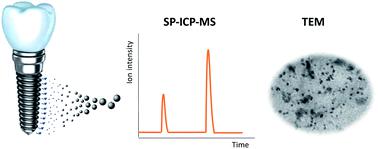当前位置:
X-MOL 学术
›
J. Anal. At. Spectrom.
›
论文详情
Our official English website, www.x-mol.net, welcomes your feedback! (Note: you will need to create a separate account there.)
Evaluation of nanodebris produced by in vitro degradation of titanium-based dental implants in the presence of bacteria using single particle and single cell inductively coupled plasma mass spectrometry
Journal of Analytical Atomic Spectrometry ( IF 3.4 ) Pub Date : 2021-07-27 , DOI: 10.1039/d1ja00154j Marzia Cosmi 1 , Nathaly Gonzalez-Quiñonez 2 , Pablo Tejerina Díaz 3 , Ángel Manteca 2 , Elisa Blanco-González 1 , Jörg Bettmer 1 , María Montes-Bayón 1 , Mario Corte-Rodriguez 1
Journal of Analytical Atomic Spectrometry ( IF 3.4 ) Pub Date : 2021-07-27 , DOI: 10.1039/d1ja00154j Marzia Cosmi 1 , Nathaly Gonzalez-Quiñonez 2 , Pablo Tejerina Díaz 3 , Ángel Manteca 2 , Elisa Blanco-González 1 , Jörg Bettmer 1 , María Montes-Bayón 1 , Mario Corte-Rodriguez 1
Affiliation

|
The bio-tribocorrosion of metallic materials used for dental implants (Ti and alloys) in the oral environment involves the production of metallic debris not only in the ionic, but also in the nanoparticulate form. The present work shows a systematic evaluation of the detection of Ti-containing nanoparticles in different biological media, including artificial saliva, in the presence of the mucosal bacterium Streptococcus mutans. The studies have been performed using single particle inductively coupled plasma mass spectrometry (SP-ICP-MS) complemented with transmission electron microscopy (TEM). The obtained results revealed lower aggregation when suspending standard TiO2 nanoparticles at neutral pH in artificial saliva and no additional effect on the agglomeration or particle size due to the presence of bacteria in the media. Then, different Ti-based dental implants made of an alloy of Ti, Al and V were incubated in the presence of artificial saliva for 48 hours to evaluate the in vitro release of metallic species. The presence of Ti-, Al- and V-containing nanoparticles was observed by SP-ICP-MS and the existence of such nanodebris was confirmed by TEM. The addition of mucosal bacteria to the media caused a significant decrease in the production of nanoparticles due to the formation of a biofilm on the surface of the incubated implants, which was further confirmed by confocal microscopy. The incubation of the implants released nanoparticles with osteoblast cells (Saos-2 cell culture) and further analysis by single-cell (SC)-ICP-MS revealed a significant uptake of the nanostructures by the bone cells with still unknown effects.
中文翻译:

使用单粒子和单细胞电感耦合等离子体质谱法评估细菌存在下钛基牙种植体的体外降解产生的纳米碎片
口腔环境中用于牙科植入物(钛和合金)的金属材料的生物摩擦腐蚀不仅包括离子形式的金属碎片,还包括纳米颗粒形式的金属碎片。目前的工作显示了在粘膜细菌变形链球菌存在的情况下,对不同生物介质(包括人工唾液)中含钛纳米颗粒的检测的系统评估。这些研究是使用单粒子电感耦合等离子体质谱 (SP-ICP-MS) 和透射电子显微镜 (TEM) 进行的。所得结果显示悬浮标准 TiO 2时聚集程度较低纳米颗粒在人工唾液中处于中性 pH 值,并且由于介质中存在细菌而不会对团聚或粒径产生额外影响。然后,由 Ti、Al 和 V 合金制成的不同钛基牙种植体在人工唾液存在下孵育 48 小时,以评估体外金属物种的释放。通过 SP-ICP-MS 观察到含有 Ti、Al 和 V 的纳米颗粒的存在,并且通过 TEM 证实了这种纳米碎片的存在。由于在培养的植入物表面形成生物膜,将粘膜细菌添加到培养基中导致纳米颗粒的产生显着减少,共聚焦显微镜进一步证实了这一点。植入物的孵化释放了纳米颗粒与成骨细胞(Saos-2 细胞培养物),并通过单细胞 (SC)-ICP-MS 进行的进一步分析揭示了骨细胞对纳米结构的显着吸收,但效果仍然未知。
更新日期:2021-08-19
中文翻译:

使用单粒子和单细胞电感耦合等离子体质谱法评估细菌存在下钛基牙种植体的体外降解产生的纳米碎片
口腔环境中用于牙科植入物(钛和合金)的金属材料的生物摩擦腐蚀不仅包括离子形式的金属碎片,还包括纳米颗粒形式的金属碎片。目前的工作显示了在粘膜细菌变形链球菌存在的情况下,对不同生物介质(包括人工唾液)中含钛纳米颗粒的检测的系统评估。这些研究是使用单粒子电感耦合等离子体质谱 (SP-ICP-MS) 和透射电子显微镜 (TEM) 进行的。所得结果显示悬浮标准 TiO 2时聚集程度较低纳米颗粒在人工唾液中处于中性 pH 值,并且由于介质中存在细菌而不会对团聚或粒径产生额外影响。然后,由 Ti、Al 和 V 合金制成的不同钛基牙种植体在人工唾液存在下孵育 48 小时,以评估体外金属物种的释放。通过 SP-ICP-MS 观察到含有 Ti、Al 和 V 的纳米颗粒的存在,并且通过 TEM 证实了这种纳米碎片的存在。由于在培养的植入物表面形成生物膜,将粘膜细菌添加到培养基中导致纳米颗粒的产生显着减少,共聚焦显微镜进一步证实了这一点。植入物的孵化释放了纳米颗粒与成骨细胞(Saos-2 细胞培养物),并通过单细胞 (SC)-ICP-MS 进行的进一步分析揭示了骨细胞对纳米结构的显着吸收,但效果仍然未知。


























 京公网安备 11010802027423号
京公网安备 11010802027423号